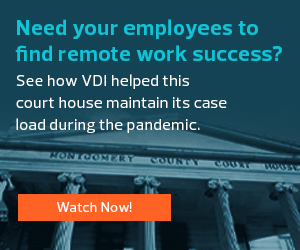Working from Home Proved Successful for Court Employees
Although the 38th Judicial District is a Pennsylvania state trial court, it is funded entirely by counties. The district looks to Montgomery County for tech support. Case meets with Olivieri every week to review court IT projects, and they had established a long-term working relationship well before the pandemic struck. Together, they were able to address the technology needs of the court very quickly.
“Most of our employees had PCs prior to the pandemic,” Case says. “So, a good number of laptops needed to be purchased in order for the staff to be able to work remotely. In addition to the hardware, whether it was a laptop, a monitor or a scanner, we also had a good deal of software needs to address, particularly when it came to videoconferencing and actually being able to conduct a hearing remotely using that technology.”
Working with Montgomery County Information and Technology Solutions, Case opened access to VMware VDI for each judicial employee. The VDI provided a common office environment for roughly 350 employees working remotely, enabling access to videoconferencing, soft phone systems and other critical applications. Judicial law clerks, for example, “can do everything they would normally do for the judge in the courthouse, through their desktops, their VDI,” Case says.
“Pre-pandemic, if you had asked me if it would be possible or likely that the court would be willing to dispose of matters remotely, I would’ve said that was highly unlikely. But frankly, the pandemic has taught us that we can in fact dispose of a good number of cases not only remotely but even oftentimes on paper, as opposed to actually even having a remote hearing or conference. So, I do think that there are going to be some long-term implications of this experiment,” Case says.
MORE FROM STATETECH: How remote work tools may help with government recruitment.
Remote Operations May Have an Impact on the Future of Government
For Case, the 38th Judicial District is successful when cases move to disposition. In 2020, the district disposed of 60 percent of listed cases without trial during remote operations, which constituted a stunning success. In a normal year, the courts would dispose of 98 percent of cases without a jury trial, but reaching the 60 percent measure during the pandemic was remarkable.
“Remote meetings can be as productive as in-person meetings. More people can be involved, because some might not have been able to travel to the meetings or get to the meetings on time. The fact that we’re using technology for meetings generally expands the world of people who are able to participate in those meetings and allows them to be extremely effective,” Case says.
The success has provided fuel for reimagining future court operations. Perhaps staff can have more flexible hours, and perhaps the court will not require alternative facilities for continuity of operations planning.
“I can say that in the 30 years I’ve worked for the courts, we’ve never experienced anything like this. We can grow on and build on the change that has taken place,” Case says.











